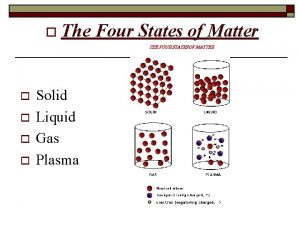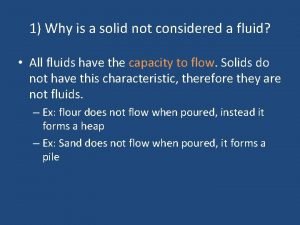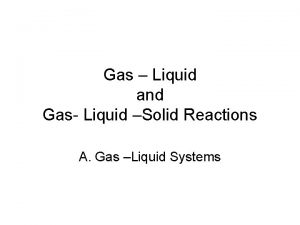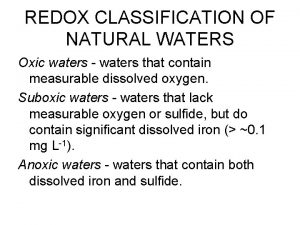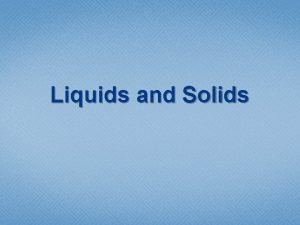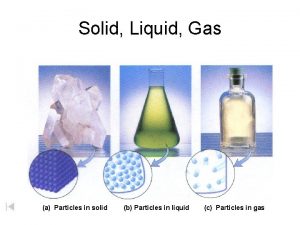Waters Sample Introduction techniques Gas Liquid and Solid







- Slides: 7

Waters Sample Introduction techniques Gas, Liquid and Solid (usually dissolved in a suitable solvent) sample introduction onto the head of the GC column in the maximum efficiency without any discrimination effects is a crucial part of GC Chromatography Gas samples have been introduced via canisters, gas tight syringes, valve system or Tedlar bags. Due to the rarity of this sample introduction technique it is not considered here. Most common method uses Microsyringes and this is addressed here. Recently much attention has been devoted to Headspace and using a solid phase medium (SPEME) to extract analytes from a gas phase and introduce this onto the

Thisneedlepoint design 3 design, is is primarily the standard withused the model square for Headspace for ‘blunt’ Autosampler edge ‘solvent-free’ end, use is predominantly (predominantly analyses (discussed used for the for* This needle The syringe needle point style 1, shown below, is the oldest design. Created @1957 – Needle point 2, has a slightly disfigured end with the more version having later), CTC). HPLCsince This separation particular it style can easily injections design sample into hasthose aonly suitable become compounds valve useful assembly present because (and within ofmodern should the a heavy advances not particulate be used made for or in 58, it allowed GC analysis since itburr was(exaggerated able to puncture the very primitive septum an composition inverted below). septa material, chemical sediment matrix GCMS without and analysis). design becoming (considered blocked. in more detail later). material around at that time. Syringe First In The the step vast in majority choosing ofacases suitable samples micro-syringe introduced is the syringe into theneedle GC using type. a The microsyringe, above syringe plunger is usually madeare from stainless steel, although some gas tightis a typically selection 0. 1 toof 10. 0µl various syringe volume needle for liquid types samples bythe to Hamilton 5000µl in (the volume standard for gas As septum compound improved withand modern manufacturing techniques plungers areincompositions available which use a produced teflon tip 10 to main plunger. manufacturer). samples. and chemistry advances, this point hasisfallen into disusefor because it rapidly Unfortunately, this needle pointstyle design not appropriate hot injection portcores out septa (compared otherlead needle pointcontamination designs) and of becomes quickly deformed. temperatures and cantooften to rapid the internal surface of the Waters injection port liner.

The external needle diameter or gauge is often quoted as a number. This refers to the Only This twoneedle internal diameter selection syringes isis are important produced; when (no letter the desired assignment) sample and number ofsome turns the needles metal needle stretched by Standard inconsidering its So aof 26 gauge Some Here are microsyringe typical syringe use needle multigauge designs values matched tomanufacture. allow Merlin to the type Microseal sample use. introduction (i. e. Slim, when designated using needle a Merlin as(the an Microseal S. - considered later). needle will be method thinner than a 23 gauge two most common gauges). introduction method. Syringe needle diameter Typical GC 23 gauge i. d. (mm) microsyringe o. d. (mm) External diameter needle gauges 26 0. 23 0. 47 26 S 0. 13 Uses On-column and Merlin port injections Internal diameter 23 23 S Waters 0. 24 0. 64 0. 15 26 gauge Standard split/splitless injection port needle

The metal needle has an @0. 7 mls internal volume. Itmost is recommended, therefore, that The AThese Unfortunately number usual adhesive syringe solvents syringe ofneedle different compound this should barrel connection syringe plungers is be iscarefully avoided partially barrel have to its connection drilled soluble at barrel been all possible out used isinan has so a but number important that higher otherwise it allows of dead common consideration. solvents, the volumes, seal metal type inleaks particular are needle leading For and made novice to the of be * an air gap @1 ml inplace volume, after thebe liquid has been aspirated, should be used organo-halides sample inserted cannot metal (such user inexcessive be abut as metal reproducibly and methyl some standard thumbscrew sealed PTFE chloride, using plungers deviation drawn dichloromethane, connection an appropriate into provide errors theis in barrel arecommended. an gas adhesive chloroform, analysis. from tight the seal. compound. sample carbon vial. tetwhen etc). injecting samples. Needle and syringe barrel Glass barrel Plunger Adhesive material Metal thumbscrew Metal needle Waters

Keeping Taking the aof small syringe amount needle of within sample the injection the port metal for ainjection short needle and allows injecting the needle to* Normally The ASmall number sample’s air gaps air This gaps should injection solvent are be allowed is plug methods kept used aids is to between toallowed agetting are clean minimum injust common the all to within penetrate the syringe solvent as sample this use. and will plug, the The into eventually provide the most the sample hot basic atime solvent port lead injection and one by to then column 42 mm plug is port. shown the atquickly (optimum the damage metal inbase the heat allows up improving low boiling high and thermally analyte sensitive transfer compounds from syringe to be into introduced the GC (‘hot-needle’ with max needle distance) toboiling cut atdown the before injection on offigure evaporation the plunger below. port over is and depressed. time. transfer losses. efficiency (‘cold injection needle’ method). injection method). Sample injection methods Solvent ‘plug’ Sample Air gaps Waters

By Lastly incorporating By replacing split mode the a injections separate internal standard (discussed standard with later) abeen reactive introduced often cause liquid, at athe products discrimination same formed time as effect from the (ie sample thethe* ‘Sandwich’ Using a sandwich manual injection samplemethods introduction have technique used often in order mitigates to carry this out discrimination. quantification, reaction amount greater accuracy of occurring analyte inin mixtures knowing the short deposited how period much the onoftwo the ainjection particular solutions columnmode head component interact is not within representative in athe mixture injection can of port the be reaction investigations and overcome discrimination effects. initial can ascertained. sample be studied. levels). Sandwich injection methods Solven t ‘plug’ Sample Air gaps Waters Internal Reactive. Standard chemical

Headspace, Purge/Trap and introduction methods. SPEME Static and Headspace has beenintroduced around since the 1990’s, early 1960’s and is ablefor to SPEME or Dynamic Solid Phase Micro Extraction, in the is more suitable provide a very clean sample a wide compounds with good sensitivity with Headspace andfrom SPEME areofother popular sample tracevariety analysis. little or no solvent. Methods Headspace Static Headspace – Dynamic (Purge and Trap) SPEME Waters % RSD Precisio n @4 Cost Analysis Solvent Time use Simplicit y Low 30 Little or minutes None Yes 1 to 30 30 High minutes None No <1 to 12 5 minutes None Yes Low



